Lazy
Treasuries were listless last week, trading in a tight range. Agency/Ginnie Mae production was similarly rudderless.
Financial markets and the government seem to have taken singer-songwriter Bruno Mars’ advice in “The Lazy Song” to heart. Mars sings that “Today, I don’t feel like doing anything.” Maybe it’s the turn of the season, or the three-day weekend, or the continued infighting in Congress, but it seems that everyone is in the same boat.
Treasury yields have been in a narrow range since the start of the shutdown on October 1. The 10-year Treasury note closed that day at a yield of 4.09%, just a couple basis points (bps) higher than the close of 4.03% on Friday. Meanwhile, the intraday high/low ranged from 4.03% to 4.18% over the eight trading days so far in October (Figure 1).
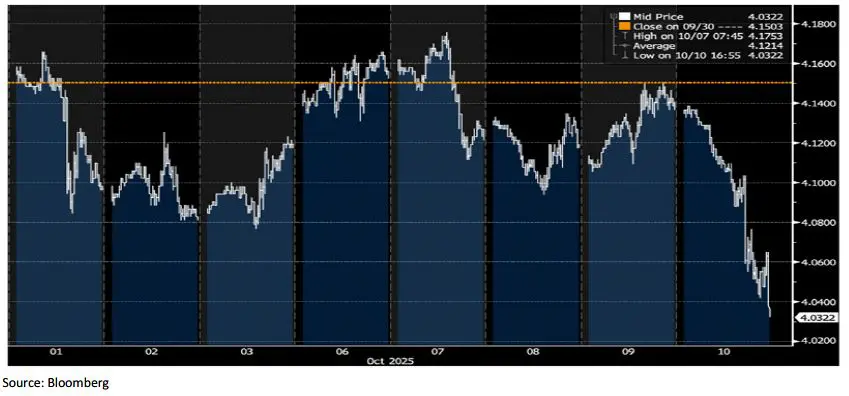
How big a deal are government shutdowns anyway? TD Ameritrade’s Ben Estep, for instance, argues that while shutdowns create scary headlines (such as Bloomberg’s recent “Shutdown Pain Ripples Through US Economy With No Deal in Sight”) and hardship for federal employees, “once previous shutdowns were resolved, there typically weren’t any significant, lasting effects on the economy or the government.” Fortunately, we don’t have to look too far back for guidance:
Scary headlines include one from December 23, 2018, by Tim Wallace of the Telegraph: “The US Government shutdown will start to trim growth after Christmas, economists believe, as Washington’s budget deadlock threatens to spill over the holiday season and into a more productive time of year.” Separately, Wallace printed that the independence of monetary policy could be under threat as Treasury Secretary Steven Mnuchin was forced to deny that President Trump had considered firing the Federal Reserve chairman.
In practice, however, the shutdown that ran from December 22, 2018, to January 25, 2019 was a nonevent from an economic growth point of view. Growth in the fourth quarter of 2018 was, indeed, slower. Yet the 35-day shutdown did little to halt output in the first quarter of 2019—GDP jumped to 2.5%—and growth in future quarters was even stronger (Figure 2).
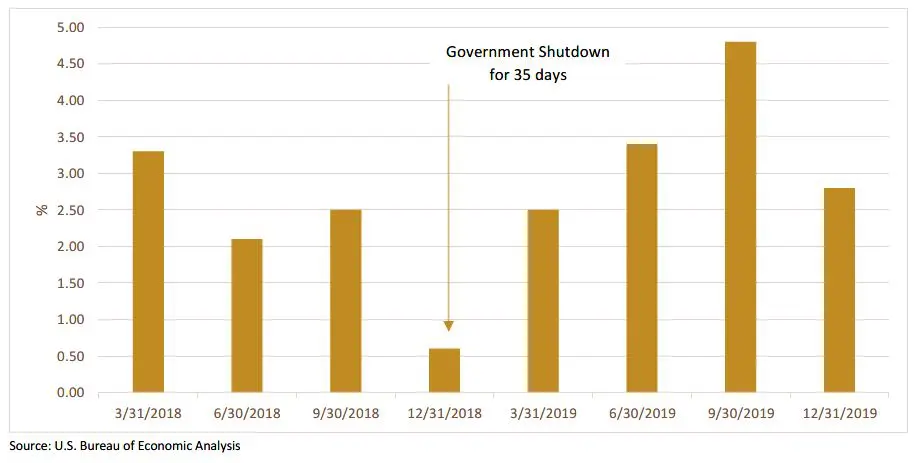
The stock market dropped in late 2018 (Figure 3) due to monetary tightening by the Fed, as well as saber rattling over the government shutdown and threats by Trump to the Fed’s independence. In an interview during that time, Mnuchin insisted that markets “overreacted” to the Fed’s tightening. “The Fed has said they’re close to done. They said they are data dependent. … U.S. equities are [a] tremendous value,” said Mnuchin. He added that the impact on the Treasury market from the Fed shrinking its balance sheet was not “as big an issue as the market seems to be focusing on.”
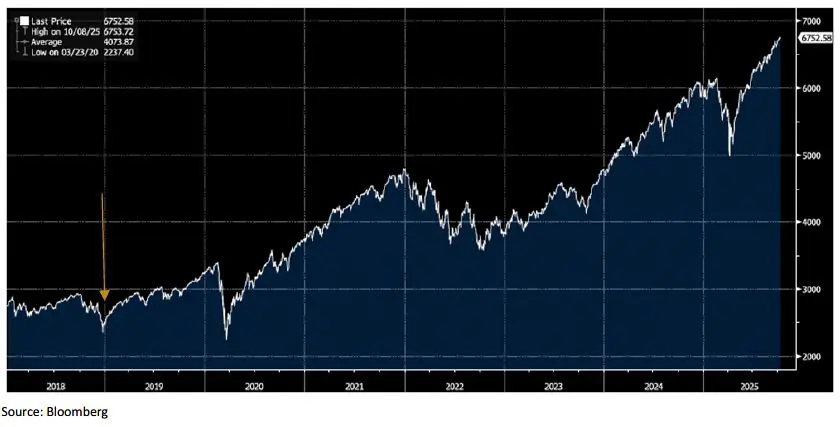
As the stock market rout of 2018 continued, Treasury bonds began to rally (Figure 4). Some likened the rally to a flight to quality. But in hindsight, Mnuchin proved correct. The equity market and GDP recovered well, and the rally proved more affected by a shift in monetary policy capped by the final rate hike in December 2018. That last hike pushed the yield curve near inversion.
Between July and October 2019, the Federal Open Market Committee (FOMC) did lower the federal funds rate from 2.50% to 1.75%. Yet the huge cut in March 2020—which brought the rate down to 0%—was in response to the pandemic, not the government shutdown of 2018–19.
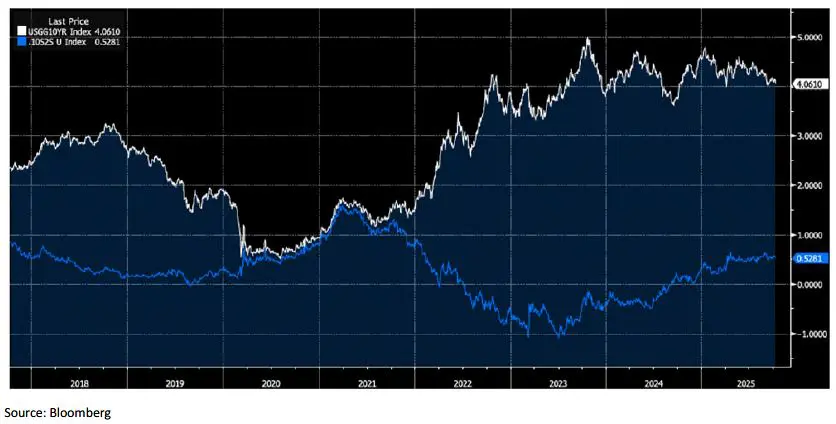
In 2018—as in 2025—headlines focused on whether rates were too high, as well as on whether Powell would be fired. Then and now, inflation was also a concern. Annual inflation in mid-2018 was rising toward 3%, well above the Fed’s 2% target (and a development that encouraged the FOMC to continue with tighter policy). Likewise, in late 2025, the Consumer Price Index (CPI) is no longer declining and is rising instead (Figure 5).
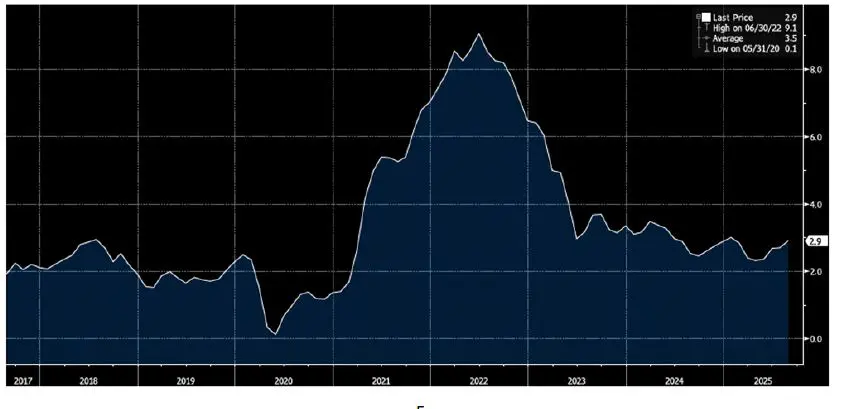
Source: Bloomberg
Government reporting of economic data will come back at some point. When it does, monetary policy officials will gauge it and alter rates as they deem appropriate, in line with their dual mandate.
In 2018, they were steadfast in their commitment to “data-driven” decisions. It’s reasonable to assume that they remain equally committed today. In 2018, financial markets also proved their ability to look perceptively through the muddy waters created by a government shutdown.
We expect continued noise out of Washington: Many politicians will try to use the current chaos as a chance to solidify their prospects in the midterm elections. While the country might still be in a “not doing anything” mood, we look forward to a future where the shutdown is behind us—which, as Mars also sang, is more “what I like.”
FROM THE DESK
Agency CMBS — Ginnie Mae spreads were mostly flat, week over week. REMIC sponsors struggled to sell bonds after weeks of tightening, but the lack of origination kept spreads steady. DUS traded orderly, with large block and full-term interest only (IO) structures performing best.
Municipals — AAA tax-exempt yields were again higher on the short end of the yield curve and lower on the long end, week over week. Despite the government shutdown, the municipal bond market tone was largely positive for the week and held up well, relative to other fixed-income sectors. The market was supported by inflows that helped get a modest new-issuance calendar priced. Spreads on short-term, cash-collateralized housing bonds and Fannie Mae M-TEBs/credit-enhanced deals held steady, relative to previous weeks. Municipal bond funds saw a second straight week of inflows, with $966 million entering (YTD inflows of $19.05 billion). High-yield funds collected $269 million of those inflows.


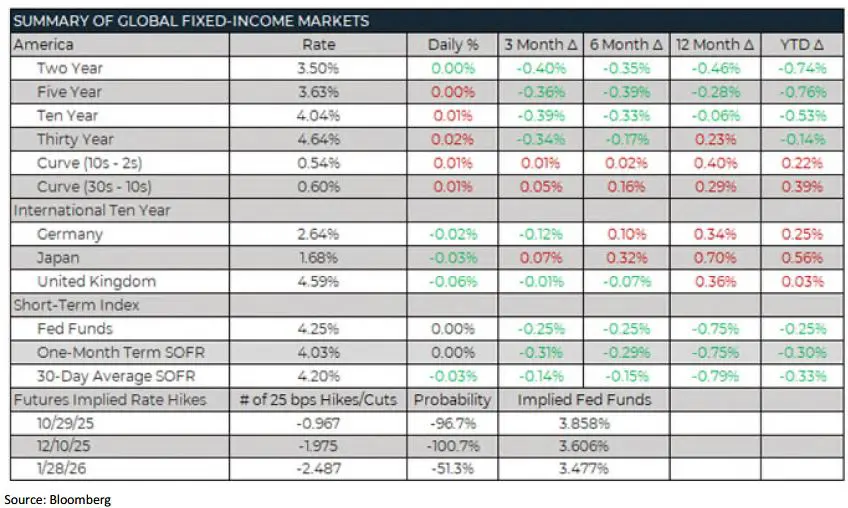
The information contained herein, including any expression of opinion, has been obtained from, or is based upon, resources believed to be reliable, but is not guaranteed as to accuracy or completeness. This is not intended to be an offer to buy or sell or a solicitation of an offer to buy or sell securities, if any referred to herein. Lument Securities, LLC may from time to time have a position in one or more of any securities mentioned herein. Lument Securities, LLC or one of its affiliates may from time to time perform investment banking or other business for any company mentioned.
